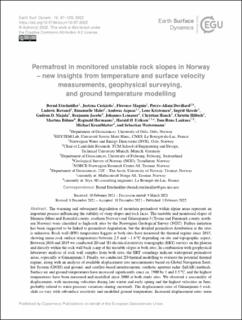| dc.contributor.author | Etzelmüller, Bernd | |
| dc.contributor.author | Czekirda, Justyna | |
| dc.contributor.author | Magnin, Florence | |
| dc.contributor.author | Duvillard, Pierre-Allain | |
| dc.contributor.author | Ravanel, Ludovic | |
| dc.contributor.author | Malet, Emanuelle | |
| dc.contributor.author | Aspaas, Andreas Grøvan | |
| dc.contributor.author | Kristensen, Lene | |
| dc.contributor.author | Skrede, Ingrid | |
| dc.contributor.author | Majala, Gudrun D. | |
| dc.contributor.author | Jacobs, Benjamin | |
| dc.contributor.author | Leinauer, Johannes | |
| dc.contributor.author | Hauck, Christian | |
| dc.contributor.author | Hilbich, Christin | |
| dc.contributor.author | Böhme, Martina | |
| dc.contributor.author | Hermanns, Reginald | |
| dc.contributor.author | Eriksen, Harald Øverli | |
| dc.contributor.author | Lauknes, Tom Rune | |
| dc.contributor.author | Krautblatter, Michael | |
| dc.contributor.author | Westermann, Sebastian | |
| dc.date.accessioned | 2022-06-08T13:03:14Z | |
| dc.date.available | 2022-06-08T13:03:14Z | |
| dc.date.created | 2022-05-20T15:24:31Z | |
| dc.date.issued | 2022 | |
| dc.identifier.citation | Earth Surface Dynamics. 2022, 10 (1), 97-129. | en_US |
| dc.identifier.issn | 2196-6311 | |
| dc.identifier.uri | https://hdl.handle.net/11250/2997952 | |
| dc.description.abstract | The warming and subsequent degradation of mountain permafrost within alpine areas represent an important process influencing the stability of steep slopes and rock faces. The unstable and monitored slopes of Mannen (Møre and Romsdal county, southern Norway) and Gámanjunni-3 (Troms and Finnmark county, northern Norway) were classified as high-risk sites by the Norwegian Geological Survey (NGU). Failure initiation has been suggested to be linked to permafrost degradation, but the detailed permafrost distribution at the sites is unknown. Rock wall (RW) temperature loggers at both sites have measured the thermal regime since 2015, showing mean rock surface temperatures between 2.5 and −1.6 ∘C depending on site and topographic aspect. Between 2016 and 2019 we conducted 2D and 3D electrical resistivity tomography (ERT) surveys on the plateau and directly within the rock wall back scarp of the unstable slopes at both sites. In combination with geophysical laboratory analysis of rock wall samples from both sites, the ERT soundings indicate widespread permafrost areas, especially at Gámanjunni-3. Finally, we conducted 2D thermal modelling to evaluate the potential thermal regime, along with an analysis of available displacement rate measurements based on Global Navigation Satellite System (GNSS) and ground- and satellite-based interferometric synthetic aperture radar (InSAR) methods. Surface air and ground temperatures have increased significantly since ca. 1900 by 1 and 1.5 ∘C, and the highest temperatures have been measured and modelled since 2000 at both study sites. We observed a seasonality of displacement, with increasing velocities during late winter and early spring and the highest velocities in June, probably related to water pressure variations during snowmelt. The displacement rates of Gámanjunni-3 rockslide co-vary with subsurface resistivity and modelled ground temperature. Increased displacement rates seem to be associated with sub-zero ground temperatures and higher ground resistivity. This might be related to the presence of ground ice in fractures and pores close to the melting point, facilitating increased deformation. The study demonstrates and discusses the possible influence of permafrost, at least locally, on the dynamics of large rock slope instabilities. | en_US |
| dc.language.iso | eng | en_US |
| dc.rights | Navngivelse 4.0 Internasjonal | * |
| dc.rights.uri | http://creativecommons.org/licenses/by/4.0/deed.no | * |
| dc.title | Permafrost in monitored unstable rock slopes in Norway-New insights from temperature and surface velocity measurements, geophysical surveying, and ground temperature modelling | en_US |
| dc.title.alternative | Permafrost in monitored unstable rock slopes in Norway-New insights from temperature and surface velocity measurements, geophysical surveying, and ground temperature modelling | en_US |
| dc.type | Peer reviewed | en_US |
| dc.type | Journal article | en_US |
| dc.rights.holder | © Author(s) 2022 | en_US |
| dc.description.version | publishedVersion | en_US |
| cristin.ispublished | true | |
| cristin.fulltext | original | |
| cristin.qualitycode | 1 | |
| dc.identifier.doi | 10.5194/esurf-10-97-2022 | |
| dc.identifier.cristin | 2026061 | |
| dc.source.journal | Earth Surface Dynamics | en_US |
| dc.source.volume | 10 | en_US |
| dc.source.issue | 1 | en_US |
| dc.source.pagenumber | 97-129 | en_US |

